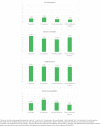Nicotine pouch awareness, use and perceptions among young adults from six metropolitan statistical areas in the United States
- PMID: 37293565
- PMCID: PMC10246475
- DOI: 10.18332/tpc/163243
Nicotine pouch awareness, use and perceptions among young adults from six metropolitan statistical areas in the United States
Abstract
Introduction: Nicotine pouches, which emerged in the US in 2016 and are marketed as 'tobacco-free', may appeal to young adults. This study examined young adults' nicotine pouch awareness, use, use intentions, and related factors.
Methods: We analyzed Spring 2022 survey data from 942 young adults recruited via social media from six US cities (mean age=27.61 years, 34.3% men, 33.1% racial/ethnic minority) to characterize nicotine pouch awareness, ever use, use intentions, exposure, and perceptions.
Results: Nicotine pouch awareness and ever use were reported by 34.6% and 9.8%, respectively. Males (AOR=1.79; 95% CI: 1.33-2.38), non-White participants (vs White; AOR=1.64; 95% CI: 1.04-2.61), and those using cigarettes (AOR=2.67; 95% CI: 1.63-4.38), e-cigarettes (AOR=2.28; 95% CI: 1.57-3.31), and smokeless tobacco (SLT) (AOR=14.46; 95% CI: 1.81-115.61) had greater odds of awareness. Among those aware of nicotine pouches, males (AOR=2.27; 95% CI: 1.33-3.85), White participants (vs Asian; AOR=0.40; 95% CI: 0.17-0.94), and SLT users (AOR=4.90; 95% CI: 1.26-18.98) had greater odds of ever use; being male (B=0.39; 95% CI: -0.67 - -0.12) and using SLT (B=1.73; 95% CI: 1.10-2.36) predicted greater use intentions. Overall, 31.4% reported past-month advertising exposure, most often via tobacco retailers (67.3%). Ever users most commonly purchased them at gas stations (46.7%). The most frequently reported use motives were to quit combusted tobacco (16.8%) and reduce tobacco smell (15.4%). Nicotine pouches were perceived as less harmful and less addictive than cigarettes, e-cigarettes, and SLT, and more socially acceptable than cigarettes and SLT.
Conclusions: Young adults were exposed to advertising, accessed nicotine pouches via various sources, and perceived these products favorably. Marketing and use surveillance is needed to monitor their impact on those likely to use them (e.g. males, SLT users).
Keywords: alternative tobacco products; health communications; marketing; nicotine pouches; tobacco industry; young adults.
© 2023 Berg C. J. et al.
Conflict of interest statement
The authors have completed and submitted the ICMJE Form for Disclosure of Potential Conflicts of Interest and none was reported.
Figures
References
Grants and funding
LinkOut - more resources
Full Text Sources
Miscellaneous

